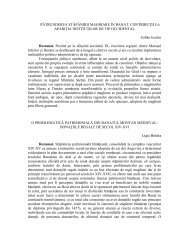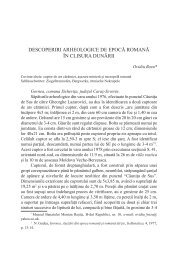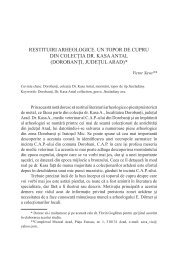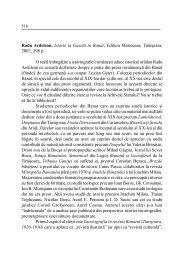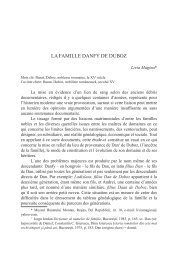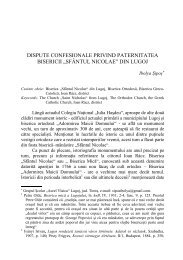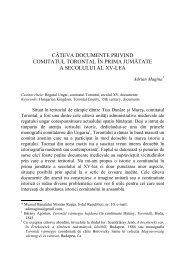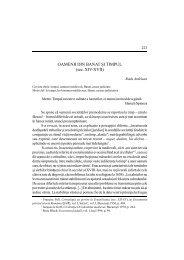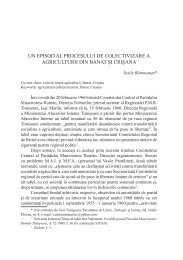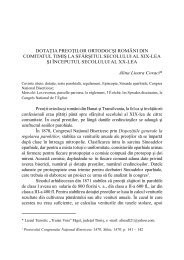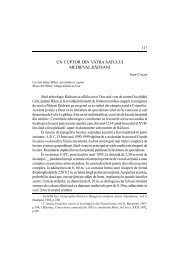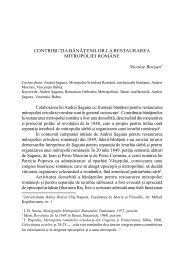Alexandru Simon - Banatica
Alexandru Simon - Banatica
Alexandru Simon - Banatica
Create successful ePaper yourself
Turn your PDF publications into a flip-book with our unique Google optimized e-Paper software.
68<br />
was therefore a complete success, at least until he crossed the Danube back<br />
into the Ottoman Empire. Bogdan III however went along with his own plans.<br />
Bogdan had already managed to find a bride. Invitations to the wedding<br />
scheduled for July had been sent out in spring 1513. Things did not go Bogdan<br />
III’s way. The wedding had to be twice postponed because of the Tartars who<br />
ravaged Moldavia. Eventually, it should have taken place in early September.<br />
At the end of August, the Tartars attacked again exactly when the situation<br />
seemed to have calmed after Bogdan III had repelled the attacks (the Polish<br />
nobles, who had not left for Suceava to attend the wedding, were very pleased<br />
for not having been enslaved during the new raid). The new attack had been a<br />
shock for Bogdan as well. Bogdan was awaiting the return of his ambassadors<br />
sent in June to Innsbruck. They had to return with his bride. According to the<br />
correspondence between Zyprian von Serntein and Lorenz Saurer (27 th of August<br />
1513), Maximilian I of Habsburg’s ‘right’ and ‘left’ hands, the bride for Bogdan<br />
III was the emperor’s personal gift and his token of greatness sent to the East 13 .<br />
Erstlich, so schreibt mir EG in seinem brief des dato<br />
stet zu Innsprugg am VIII-ten tag Augusti der Walacheyschen botschaft halber<br />
wie die durch Kay May widerumb an Haim zu Irem Herren<br />
zu ziehen abgefertigt, unnd das I Kay May Fridrichen<br />
Harber mit bestimbten Walachen in die Walachey zu ziehen verordnet den ich<br />
Kaiser-Papstplanes Maximilians I. im Jahre 1511, in MIÖG, LXXI, 1963, p. 311-332; K.M.<br />
Setton, Pope Leo X and the Turkish Peril, in Memoirs of the American Philosophical Society,<br />
CXIII, 1969, 6, p. 367-424; A. Kubinyi, Hungary’s Power Factions and the Turkish Threat in<br />
the Jagellonian Period (1490-1526), in Fight against the Turk, p. 115-145 (especially p. 129-<br />
136).<br />
13 HHStA, R.H.K., Maximiliana, fasc. 23a-1, f. 133 r (27 th of August 1513; at that time, the<br />
Tartars had just attacked). Other data on the mission (still unavailable to us): Landes- und<br />
Regierungsarchiv von Tirol/ Tiroler Landesarchiv, Innsbruck, Maximiliana, fasc. XIII-256, ff.<br />
49 r -50 r (9 th of July 1513); Relaţiile istorice dintre popoarele URSS şi România în veacurile XVînceputul<br />
celui de al XVIII-lea, I, 1408-1632, edited by J.S. Grosul, A.C. Oţetea, A.A. Novoselski,<br />
L.V. Cerepnin, Bucharest-Moscow, 1966, no. 11, p. 73, no. 26, p. 87; no. 28, p. 90 (at first, in<br />
1511, the new Moldavian-Musovite plans had apparently been sanctioned by Wladislaw II’s as<br />
well, whose envoys accompanied Bogdan III’s messengers to Moscow, even if only in order to<br />
make sure that any anti-Polish action from Vasili III and Bogdan III would cause Buda as little<br />
as possible damage); Theodor Holban, Noi documente româneşti din arhivele polone şi franceze<br />
(I), in AIIA Iaşi, XV, 1978, p. 475-484 (here no. 3, p. 482); Acta Tomiciana, II, no. 253, p. 205;<br />
nos. 269-270, p. 217-218; nos. 296-298, p. 226-227; Hurmuzaki, II-3, nos. 94-96, p. 87-89; nos.<br />
100-101, p. 92-93; nos. 103-106, p. 94-96; <strong>Simon</strong>, Fata de la nemţi, p. 103-105. Ştefan Sorin



